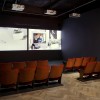Walking into the exhibition Hilma af Klint: A Pioneer of Abstraction in Moderna Museet, Stockholm, is like entering a pastel-coloured psychedelic world. Abstract forms, numbers, sketches and figures inhabit the exhibition space and nurse the audience into an almost meditative state.
Hilma af Klint was notoriously private during her lifetime, refusing to show any of her paintings to her contemporaries. She went as far as to state in her will that her works were not to be revealed to the public until 20 years after her death. As a result, she was never recognised for her work in her lifetime. However, the exhibition quickly cements her status as being the bona fide ‘Abstract Pioneer’ – emphasising her historical value as an abstract artist years before Kandinsky and Mondrian.
The spiritual world is central to af Klint’s art and follows throughout the exhibition as a dominant subject. She claimed that her hand was guided by a higher power that would steer her strokes and was constantly striving to reveal the world behind visible reality; a spiritual dimension of life. Still, though geometry has a central part in her painting, she never emerges as a perfectionist as the paint often overlaps and glides outside its figured borders. At times the strokes become almost aggressive and appear as if they were painted in a single movement. She claimed that she was never conscious of what she was painting and that her hand was guided by a higher consciousness, that through her it would convey and communicate its messages.
Moderna Museet has given the exhibition plenty of space to show af Klint’s spanning artistry, from examples of her early landscape paintings to metre high, abstract works filled with forms and colors. They manage to avoid a scattered impression, with the paintings given enough space to breathe and for the audience to absorb each piece individually. Although the exhibition might seem calm at first glance, the longer one stays inside, one becomes aware of a power that expands out of the paintings’ otherwise tranquil surface.
The exhibition has created a space for a fascinating artistry that was far ahead of its time and offers a great opportunity for new audiences to get a glimpse of the world of Hilma af Klint. But mostly it touches upon ones own unconsciousness and stimulates a curiosity for what lies beyond the everyday world we are so used to seeing.











